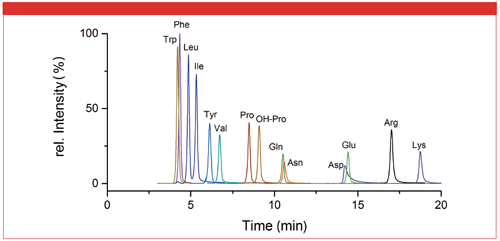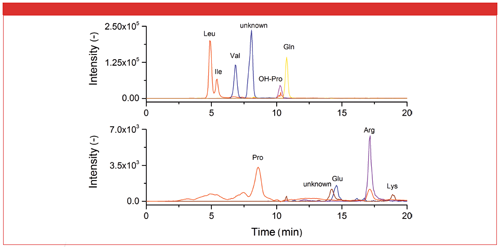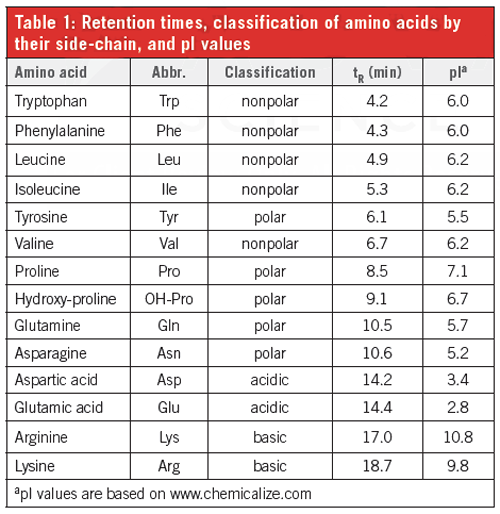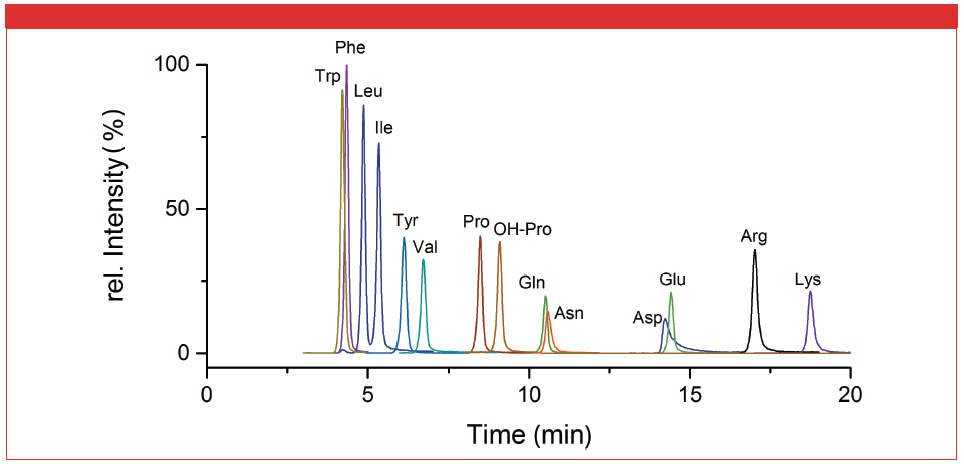Direct Analysis of Amino Acids by HILIC–ESI-MS
The Application Notebook
Hydrophilic interaction liquid chromatography coupled to electrospray ionization mass spectrometry (HILIC–ESI-MS) has been established as a method to separate and quantify polar and ionic analytes in a direct way for two decades. HILIC separation is based on the polarity of analytes, so the more polar analytes have stronger retention on a HILIC column.
Alexander Schriewer1, Katharina Johanna Heilen1, Heiko Hayen1, and Wen Jiang2,1Institute of Inorganic and Analytical Chemistry, University of Münster, Münster, Germany, 2HILICON AB
Hydrophilic interaction liquid chromatography coupled to electrospray ionization mass spectrometry (HILIC–ESI-MS) has been established as a method to separate and quantify polar and ionic analytes in a direct way for two decades. HILIC separation is based on the polarity of analytes, so the more polar analytes have stronger retention on a HILIC column.
Highly polar amino acids carry great biological weight because they are the basic structural units of proteins or enzymes. Accordingly, they are an essential part of plants, animals, and humans. Quantitative analysis of amino acids is crucial in many fields including clinical diagnostic, biomedical research, and food science (1). Amino acids are classically analyzed by gas chromatography (GC), cation exchange (CEX) or reversed-phase liquid chromatography (LC) with UV absorbance, fluorescence detection (FD), or mass spectrometry (MS) (1). However, pre-column or post-column derivatization is often needed to address either the retention problem or the detection issue. HILIC and ESI-MS is a perfect match for analyzing amino acids in a direct and fast manner (2).
In this application, we separated 14 amino acids with an iHILICâFusion(+) column packed with charge modulated hydroxyethyl amide silica. A mixed interaction-for example, hydrophilic partitioning, weak electrostatic interactions, and hydrogen bonding-may be involved in the HILIC separations.
Experimental
LC–MS System: Agilent 1100er LC system and Thermo Fisher LTQ™ equipped with a HESI source, operated in positive ionization mode for analysis of standards. For the dietary supplement, an Orbitrap™ Exactive classic equipped with a HESI source and operated in positive ionization mode.
Column: 150 × 2.1 mm, 3.5-μm iHILIC-Fusion(+) (P/N 100.152.0310, HILICON AB)
Gradient Elution: A) acetonitrile–water–1 M ammonium acetate, pH 5.75 (90:5:5); B) water–acetonitrile–1 M ammonium acetate, pH 5.75 (90:5:5); 0–0.5 min (90:10) A–B; 0.5 to 25 min, gradient elution from (90:10) A–B to (60:40) A–B.
Flow Rate: 0.3 mL/min
Column Temperature: 40 °C
Injection Volume: 5 μL
Amino Acids: Arginine, asparagine, aspartic acid, glutamic acid, glutamine, hydroxyl-proline, isoleucine, leucine, lysine, phenylalanine, proline, tryptophan, tyrosine, and valine. 50 µM of each amino acid was dissolved in water–acetonitrile (25:75) solution.
Dietary Supplement: Whey Prime (Prozis). A 20 mg/mL measure was dissolved in water and then filtered. The sample was further diluted to 2 mg/mL for injection.
Results and Conclusion
As shown in Figure 1, 14 standards of proteinogenic amino acids can be simultaneously determined using a iHILIC-Fusion(+) column coupled with ESI-MS detection. The retention times, classification of amino acids, and pI values are summarized in Table 1. As expected, the amino acids with a nonpolar side chain like tryptophan, phenylalanine, leucine, and isoleucine eluted first with the lowest interactions with the HILIC stationary phase. The polar amino acids like proline, glutamine, or asparagine had more retention and were mainly retained by hydrophilic partitioning. The acidic and basic amino acids are not neutral and had extra electrostatic interactions with the stationary phase. Interestingly, it was found that the constitutional isomers leucine and isoleucine were almost baseline separated in a generic linear gradient elution.
Figure 1: Extracted ion chromatograms of amino acid standards in HILIC separation with iHILIC-Fusion(+).

In the second step, we verified the applicability of the newly developed method using a dietary supplement containing various numbers of amino acids. As can be seen in Figure 2, leucine and isoleucine are well separated. Valine, glutamine, and hydroxyproline present intense signals. In addition, proline, glutamic acid, arginine, and lysine were also detectable at lower intensities.
Figure 2: Extracted ion chromatograms of amino acids in dietary supplement.

This work demonstrates that amino acids can be easily identified through a HILIC–ESI-MS method. It offers the possibilities to quantify this group of polar analytes in many application areas such as medicine, biology, or nutritional science.

References
- H. Kaspar, K. Dettmer, W. Gronwald, and P.J. Oefner, Anal. Bioanal. Chem.393, 445–452 (2009).
- M. Dell’mour, L. Jaitz, E. Oburger, M. Puschenreiter, G. Koellensperger, and S. Hann, J. Sep. Sci. 33, 911–922 (2010).

HILICON AB
Tvistevägen 48, SE-90736 Umeå, Sweden
Tel.: +46 (90) 193469
E-mail:info@hilicon.comWebsite:www.hilicon.com

Assessing Thorium-Peptide Interactions Using Hydrophilic Interaction Liquid Chromatography
February 4th 2025Paris-Saclay University scientists used hydrophilic interaction liquid chromatography (HILIC) coupled to electrospray ionization mass spectrometry (ESI-MS) and inductively coupled plasma mass spectrometry (ICP-MS) to assess thorium’s interaction with peptides.

.png&w=3840&q=75)

.png&w=3840&q=75)



.png&w=3840&q=75)



.png&w=3840&q=75)










